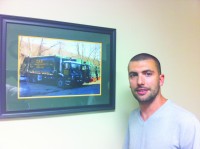Home Guru: We Know Where Garbage Comes From But Where Does It Go?

When my home was built in the 1730s, its owners took care of their household garbage in a fairly simple manner: they dug a hole in the ground and buried it. As a result, many times I’ve unearthed broken china and other 18th century artifacts when I’ve dug a garden.
Today we don’t have to dig a hole. Our only responsibility to rid ourselves of our garbage is to get it to the curb prior to pick up time by our municipal or private service.
Easy.
But what happens to the garbage after it’s swallowed and compacted in that big green truck that rumbles down my street early in the morning twice a week? Curious, I called the hauling company whose name is on the truck, CRP Sanitation. The phone was picked up by Anthony Carbone, operations manager of the family-owned company located on seven acres in Cortlandt Manor near Camp Smith.
Meeting with Carbone, I learned that CRP was established in 1979 as a small private hauler and today services more than 25,000 households in Westchester County. It is one of several carting companies in our region which have contracts with municipalities to pick up residents’ garbage.
Some towns and cities, like White Plains, Croton, Greenburgh, and Yonkers, have their own sanitation departments, Carbone said, but the majority find it more efficient to contract with private companies like CRP. In some areas, however, such as in some towns in Putnam County and pockets in Westchester around the Bedford and Lewisboro areas, residents must contract individually with a garbage hauler.
As for me, I say, charge it to my tax bill and take care of it for me. It’s a big job with a big price tag. For instance, in Yorktown, CRP services 13,000 homes twice a week for garbage pick up and once for recyclables and the cost is $250,000 per month.
And it’s not easy work, especially for those young sanitation workers who jump on and off the backs of the trucks.
“They have to be fit,” Carbone said. “They have to be out early, starting at 6 a.m., when we pick up on the major roads before the peak traffic hours of morning rush. And it’s hard work from the minute they step out of the truck.”
Asked if the sanitation workers prefer handling plastic bags or garbage pails, Carbone confirmed my assumption that they preferred the bags.
“We see a lot of shoulder and back problems from lifting those heavy 35-gallon pails, and some homeowners use 100-gallon pails, which are really more designed for trucks with a wench.”
Carbone told me that prior to 1984 our garbage was taken to landfills in our region, such as the one at Croton Point, but after that facility was filled to capacity and closed, the municipalities of Westchester joined forces to build the Charles Point waste-to-energy facility, also referred to as the “burn plant,” now owned by Wheelabrator Technologies, a corporation headquartered in Massachusetts which operates similar facilities around the country.
The process used at Wheelabrator, a mammoth square building with one looming stack, is a fascinating study of engineering.
My garbage and yours goes from the garbage truck directly to the plant where the refuse is dumped into a concrete receiving pit. From there, overhead cranes transfer the trash into one of three boilers’ feed hoppers. Inside each boiler, the refuse goes through a combustion process where temperatures exceed 2500 degrees Fahrenheit to allow complete combustion to take place.
The thermal energy released by the combustion process is converted into electrical energy and sold to Con Edison. Any waste is handled by state-of-the-art dry scrubbers which control pollutants and filter particulate matter, thoroughly meeting all environmental standards. The only evidence of the process is the whiff of white smoke rising cleanly to the heavens. What is left to discard is ash, representing a 95 percent reduction in volume from the incoming trash. That ash was deposited in the nearby Cortlandt ash pit until it was recently closed and topped off. Today that ash travels to a land fill out of state.
Even our bulk pick-up is handled in this manner, so the earthly remains of that old wing back chair I bought in my 20s are located in a land fill somewhere in Massachusetts.
Now we know where it all goes.
Bill Primavera is a licensed Realtor® associated with Coldwell Banker and a lifestyles columnist who writes regularly as The Home Guru. For those seeking advice on home maintenance or who want to buy or sell a home, visit his website, www.PrimaveraHomes.com, or call him directly at 914-522-2076.
